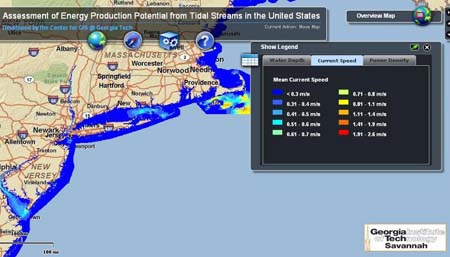The tides can be a great source of energy, as evidenced by recent news on the Scottish tidal turbines.
Now, several researchers from Georgia Tech, in cooperation with the U.S. Department of Energy (DOE), have created an interactive map showing the potential energy available in the nation’s tidal streams.

The online database shows not only ocean tides, but also plots out streams, rivers and bays, all of which are subject to daily tides and could be sources of tidal energy.
Since tides can be predicted, the information in the database is a good representation of potential power tidal turbines can create. This project is the first of its kind and has been made publicly available after the DOE’s Oak Ridge Lab validated its accuracy.
Users can zoom in and pan over maps that are color-coded based on water depth, mean current speed and mean kinetic power density.
According to the DOE, “The database is highly flexible – users can produce maps of depth and power density and select specific locations to build velocity and power density histograms, which are displayed as easy-to-read charts and graphs.”
There are no tidal power plants up and running in the United States, but Georgia Tech believes this database will help bring attention to a source of renewable energy that is reliable and predictable.
According to the university, the most favorable conditions for large-scale tidal power are in the Pacific Northwest and the Northeast, while also providing energy on a local scale in remote coastal communities and islands.






